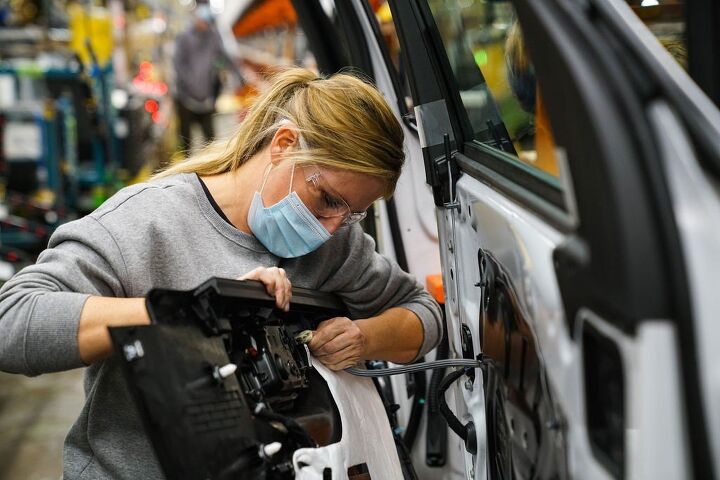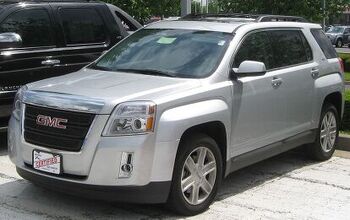Unifor Strike Targets General Motors in Canada

While the United Auto Workers (UAW) decided to implement an aggressive strike campaign that bucks some of the historical trends American union leadership feels did not serve the cause in the past, Canada’s Unifor has vowed to take a more measured approach during its contract negotiations with the industry. However, that does not mean simply rolling over for automakers in order to strike any old deal.
Last week, Unifor criticized General Motors for failing to meet important elements of its pattern agreement with Ford Motor Company. With both sides failing to make any tentative agreements by the Monday deadline, Unifor has announced plans to strike in Ontario — hindering the company’s ability to manufacture light and heavy-duty pickups.
The Canadian walkout is reportedly down to GM "stubbornly refusing" to match the contract the labor union had already reached with Ford, including a wage increase of up to 25 percent and improved benefits. Demands are similar to what we’ve seen from the UAW.
"The company continues to fall short on our pension demands, income supports for retired workers, and meaningful steps to transition temporary workers into permanent, full-time jobs," Unifor National President Lana Payne stated.
With the UAW having been striking since mid-September, automakers are already assumed to be losing millions of dollars each week due to production shortfalls. Unifor is targeting GM's Oshawa assembly complex, St. Catharines powertrain plant, and Woodstock parts distribution center. This will further hamper the company’s ability to manufacture the extremely lucrative Silverado pickup as well as the powertrains those (and other) GM products use.
The automaker has said it would “remain at the bargaining table” and remains “committed to keep working with Unifor to reach an agreement that is fair and flexible.” But it also claimed to be disappointed that a deal failed to be reached with the union after “very positive progress on several key priorities over the past weeks.”
Unifor is similarly disappointed. But said that GM failed to adhere to the pattern agreement made with Ford, leaving the union with no other recourse.
That agreement applies to over 5,600 Canadian employees located at Ford factories and has already been ratified by a narrow majority of union members. It offers a nearly 20 percent wage hike (25 for trades over a lifetime agreement), general wage increases over the next three years (with a 10 percent bump coming in 2024), a restoration of cost-of-living adjustments, the timeline for standard wage progression to be halved to just 4 years, improvements to all pension plans, a $10,000 Productivity and Quality bonus for full-time employees ($4,000 for part-timers), improvements to healthcare, improvements to retirement benefits, special EV transition measures for workers located at Ford’s Oakville Assembly, and more.
[Image: General Motors]
Become a TTAC insider. Get the latest news, features, TTAC takes, and everything else that gets to the truth about cars first by subscribing to our newsletter.

A staunch consumer advocate tracking industry trends and regulation. Before joining TTAC, Matt spent a decade working for marketing and research firms based in NYC. Clients included several of the world’s largest automakers, global tire brands, and aftermarket part suppliers. Dissatisfied with the corporate world and resentful of having to wear suits everyday, he pivoted to writing about cars. Since then, that man has become an ardent supporter of the right-to-repair movement, been interviewed on the auto industry by national radio broadcasts, driven more rental cars than anyone ever should, participated in amateur rallying events, and received the requisite minimum training as sanctioned by the SCCA. Handy with a wrench, Matt grew up surrounded by Detroit auto workers and managed to get a pizza delivery job before he was legally eligible. He later found himself driving box trucks through Manhattan, guaranteeing future sympathy for actual truckers. He continues to conduct research pertaining to the automotive sector as an independent contractor and has since moved back to his native Michigan, closer to where the cars are born. A contrarian, Matt claims to prefer understeer — stating that front and all-wheel drive vehicles cater best to his driving style.
More by Matt Posky
Latest Car Reviews
Read moreLatest Product Reviews
Read moreRecent Comments
- Bd2 Lexus is just a higher trim package Toyota. ^^
- Tassos ONLY consider CIvics or Corollas, in their segment. NO DAMNED Hyundais, Kias, Nissans or esp Mitsus. Not even a Pretend-BMW Mazda. They may look cute but they SUCK.I always recommend Corollas to friends of mine who are not auto enthusiasts, even tho I never owed one, and owned a Civic Hatch 5 speed 1992 for 25 years. MANY follow my advice and are VERY happy. ALmost all are women.friends who believe they are auto enthusiasts would not listen to me anyway, and would never buy a Toyota. They are damned fools, on both counts.
- Tassos since Oct 2016 I drive a 2007 E320 Bluetec and since April 2017 also a 2008 E320 Bluetec.Now I am in my summer palace deep in the Eurozone until end October and drive the 2008.Changing the considerable oils (10 quarts synthetic) twice cost me 80 and 70 euros. Same changes in the US on the 2007 cost me $219 at the dealers and $120 at Firestone.Changing the air filter cost 30 Euros, with labor, and there are two such filters (engine and cabin), and changing the fuel filter only 50 euros, while in the US they asked for... $400. You can safely bet I declined and told them what to do with their gold-plated filter. And when I changed it in Europe, I looked at the old one and it was clean as a whistle.A set of Continentals tires, installed etc, 300 EurosI can't remember anything else for the 2008. For the 2007, a brand new set of manual rec'd tires at Discount Tire with free rotations for life used up the $500 allowance the dealer gave me when I bought it (tires only had 5000 miles left on them then)So, as you can see, I spent less than even if I owned a Lexus instead, and probably less than all these poor devils here that brag about their alleged low cost Datsun-Mitsus and Hyundai-Kias.And that's THETRUTHABOUTCARS. My Cars,
- NJRide These are the Q1 Luxury division salesAudi 44,226Acura 30,373BMW 84,475Genesis 14,777Mercedes 66,000Lexus 78,471Infiniti 13,904Volvo 30,000*Tesla (maybe not luxury but relevant): 125,000?Lincoln 24,894Cadillac 35,451So Cadillac is now stuck as a second-tier player with names like Volvo. Even German 3rd wheel Audi is outselling them. Where to gain sales?Surprisingly a decline of Tesla could boost Cadillac EVs. Tesla sort of is now in the old Buick-Mercury upper middle of the market. If lets say the market stays the same, but another 15-20% leave Tesla I could see some going for a Caddy EV or hybrid, but is the division ready to meet them?In terms of the mainstream luxury brands, Lexus is probably a better benchmark than BMW. Lexus is basically doing a modern interpretation of what Cadillac/upscale Olds/Buick used to completely dominate. But Lexus' only downfall is the lack of emotion, something Cadillac at least used to be good at. The Escalade still has far more styling and brand ID than most of Lexus. So match Lexus' quality but out-do them on comfort and styling. Yes a lot of Lexus buyers may be Toyota or import loyal but there are a lot who are former GM buyers who would "come home" for a better product.In fact, that by and large is the Big 3's problem. In the 80s and 90s they would try to win back "import intenders" and this at least slowed the market share erosion. I feel like around 2000 they gave this up and resorted to a ton of gimmicks before the bankruptcies. So they have dropped from 66% to 37% of the market in a quarter century. Sure they have scaled down their presence and for the last 14 years preserved profit. But in the largest, most prosperous market in the world they are not leading. I mean who would think the Koreans could take almost 10% of the market? But they did because they built and structured products people wanted. (I also think the excess reliance on overseas assembly by the Big 3 hurts them vs more import brands building in US). But the domestics should really be at 60% of their home market and the fact that they are not speaks volumes. Cadillac should not be losing 2-1 to Lexus and BMW.
- Tassos Not my favorite Eldorados. Too much cowbell (fins), the gauges look poor for such an expensive car, the interior has too many shiny bits but does not scream "flagship luxury", and the white on red leather or whatever is rather loud for this car, while it might work in a Corvette. But do not despair, a couple more years and the exterior designs (at least) will sober up, the cowbells will be more discreet and the long, low and wide 60s designs are not far away. If only the interiors would be fit for the price point, and especially a few acres of real wood that also looked real.


































Comments
Join the conversation
GM was afraid of a ton of Payne.
The agreement basically mirrors the one that UNIFOR negotiated with Ford Canada. And that only received a 54% in favour vote by the UNIFOR members at Ford. GM however has generally an older workforce, so the pension clause will add more cost to GM than to Ford. What shocked me the most is that there were only 4,300 UNIFOR members in the bargaining unit(s) involved. I remember when GM employed well over 10,000 in Oshawa alone.
Next up is Stellantis (Chrysler) Canada which shockingly is the largest employer of unionized auto workers in Canada among the D3 with just over 8,000.
Union leadership expects a much tougher time with Stellantis. Perhaps because there are currently no vehicles for Brampton and the mini-vans in Windsor are not exactly hot sellers.